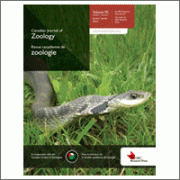Effects of Water Temperature on Laboratory Swimming Performance and Natural Activity Levels of Adult Largemouth Bass
AUTHOR(S): Caleb T. Hasler, Cory D. Suski, Kyle C. Hanson, Steven J. Cooke, David P. Philipp, Bruce L. Tuftsa
CITATION:
Hasler, C.T., C.D. Suski, K.C. Hanson, S.J. Cooke, D.P. Philipp, and B.L. Tufts. 2009. Effect of water temperature on laboratory swimming performance and natural activity levels of adult Largemouth Bass. Can. J. Zool. 87(7): 589–596. https://doi.org/10.1139/Z09-044
ABSTRACT:
Although locomotory performance in vertebrates is related to fitness, most performance tests are conducted in a laboratory setting, or in a manner that forces the organism to move not of their own volition. Biotelemetry offers the possibility to measure voluntary activity in a natural setting and provides the opportunity to combine laboratory-derived data with field studies on wild fish.
In this study, it was found that laboratory- and field-based measurements of swimming performance and voluntary activity resulted in similar general seasonal trends, though each measurement assessed a different swimming type. In the field, all swimming metrics were lower at cooler water temperatures and were lowest during early winter (mean daily activity = 0.016 BL/s; mean voluntary swimming activity = 0.04319 BL/s; maximum swimming speed = 0.17 BL/s). In the laboratory, fish acclimatized to 25.0, 14.0, and 7.5 °C decreased swimming performance (Ucrit) with water temperature (25.0 °C (2.17 BL/s); 14.0 °C (1.69 BL/s); 7.5 °C (1.17 BL/s). Although some species and tissues have been shown to exhibit different degrees of thermal adaptation, these results show that swimming, one of the most important functions in fish, is largely dependent on environmental temperature, at least in Largemouth Bass (Micropterus salmoides [Lacepède, 1802]).
FULL TEXT – Hasler et al.



